MyndNotes digital app
Bringing the gap between digital and paper note-taking
The story behind MyndNotes app
The Vision
My vision is to design MyndNotes to bridge the gap between structured organization and creative freedom. To be a space where:
- Your notes remain searchable, categorized, and connected
- You can seamlessly move between paper and digital, enhancing creativity without losing structure
- You can easily switch between sketching and structured notes
The challenge
As a creative professional, I’ve always struggled to find the perfect note-taking solution – one that allows me to capture and organize ideas in a way that truly supports my creative process.
- Paper notebooks lacked searchability and structure.
- Digital apps weren’t flexible enough for sketching and idea mapping.
- I wanted one place for creative ideas, projects, and brainstorming.

“I want to create something that helps creatives capture inspiration instantly”
Example persona: struggles & pain points
For MyndNotes App, personas ensure the product meets the specific needs of creative professionals.
Key Benefits
- Targeted Features
Understanding how illustrators, designers, and writers take notes allows for better feature prioritization.
- Better UI & UX Decisions
Designing with a clear persona in mind ensures intuitive interactions and workflows - Define target groups
Find the best target audience for the interviews

“It is important for the product to answer on the users needs and to find the right target group.”
#Personas
User research and Interviews
This research explores the note-taking habits, challenges, and needs of creative professionals. The study is based on interviews with seven professionals: an illustrator, a two graphic designers, a UX designer, a multidisciplinary designer and a two marketing specialists.
Anna Mitkova
Visual communication designer
Interested in: Interior design
Question: Do you prefer paper or digital tools for brainstorming, and why?
Answer: Both. If I’m working alone, I immediately start creating a board in tools like FigJam, Miro, or Milanote. However, if I’m in a meeting, I take notes and create diagrams on paper, in a notebook.
Research objectives
- Understand how creative professionals take and organize notes
- Identify key pain points in their current workflow
- Explore opportunities for MyndNotes to enhance their process
Research findings
Combination of Paper & Digital
- Participants use both formats but in different ways
- Paper is preferred for brainstorming, quick sketches, and meetings
- Digital tools are used for organizing, storing, and sharing notes
Scattered notes across multiple tools
- Many struggle with fragmented note-taking across notebooks, sticky notes, and apps like Google Docs, Notion, and Jira
- Paper is preferred for brainstorming, quick sketches, and meetings
Creative freedom vs. organization
- Users love the freedom of handwriting but need structure to keep notes accessible
- A major frustration is the inability to easily link handwritten notes to digital workflows
#User interviews
#Contextual inquiry
Problems & Insights
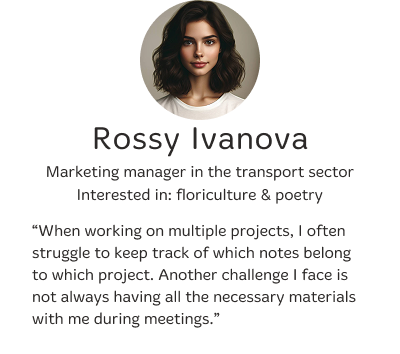
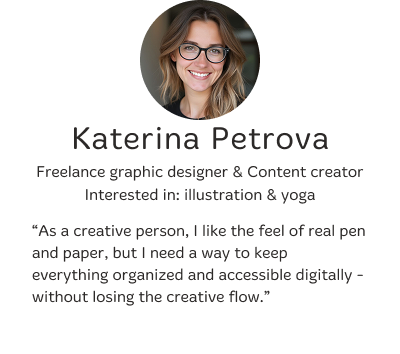
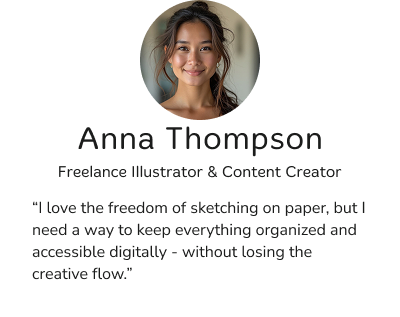
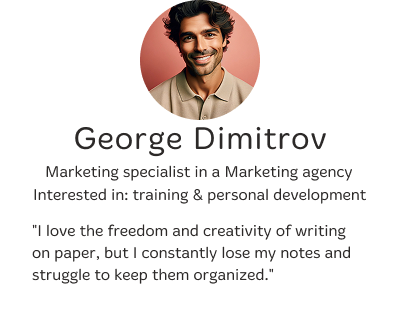
Paper
- Struggle to organize paper notes
Many prefer writing by hand, but find it frustrating that handwritten notes are not easily searchable - Paper notes get lost, or people get lost in them
Often, people struggle to keep track of handwritten ideas. Some notes get lost, others can’t be found easily - No possibility to share
No streamlined way to share or work on handwritten notes with others
Digital
- Difficult transitions between paper & digital
Manual transcription is tedious, and existing tools don’t support fluid movement between formats - Digital note-taking lacks freedom & creativity
Sketching and handwriting is a key part of thinking. Creatives need paper to organize their thoughts. - Digital mediums lack the tactile feeling of paper
Some creatives prefer the feeling of writing on real paper and the beautiful design of the notebooks.
“Many creatives struggle to organize handwritten and digital notes together.”
#Affinity mapping
Competitive analysis
Several tools currently exist to assist with digital note-taking and organization. Here is a comparison of some of the most relevant competitors:
TOOL
Strengths
Weaknesses
Notion
Lacks seamless handwritten note integration
Great for structured organization, tagging, and collaboration
Trello
Great for project and task management
Not suited for freeform note-taking or handwritten content
Notability
Great for handwritten notes and audio recording
Limited organization features and not optimized for project tracking
Todoist
Strong task management and to-do lists
Not designed for handwritten notes or sketching
Whitelines
Innovative paper with built-in digitization for seamless paper-to-digital transition
Requires specific physical notebooks and is limited in app integrations
Key features to aim for MyndNotes
- Seamless paper-to-digital synchronization
- Tagging & smart categorization
Provides a structured organization for handwritten notes - Collaboration & task integration
- Creative-centric approach
Designed specifically for illustrators, designers, and content creators, addressing their unique workflow needs
Notes
- Based on the interviews, creatives use Notion, Trello, and Todoist daily – either for work or personal projects.
- Other digital tools creatives use: Figjam, Miro, Milanote, Jira, Confluence
“In searching for the tool that combines both traditional and digital mediums.”
#Competitive analysis
Feedback from creatives
Through interviews, I explored how different creatives work and take notes, as well as what features would be most valuable. These insights guided my conclusions and next steps for MyndNotes App.
Feature requests
- Seamless paper-to-digital sync
A fast and easy way to scan, categorize, and organize handwritten notes - Searchable handwriting recognition
Ability to convert handwritten notes into searchable, editable text - Idea prioritization & progress tracking
Marking important notes and seeing idea evolution over time - Smart tagging & categorization
Users want an automatic way to sort notes by project, client, or meeting - Integration with existing tools
Users want to connect MyndNotes with platforms like Notion, Trello, and Google Drive - Collaboration & Sharing
Easy export and sharing options for team-based workflows
Workflow & Process Observations
- Note-taking is multi-stage
Many users take raw notes first, then refine and structure them later - Frequent switching between tools
Users constantly switch between paper, digital apps, and project management tools - Task & idea tracking needs differ
Some use notes primarily for capturing inspiration, while others rely on structured to-do lists - Sketching is a key part of thinking
Designers and illustrators often sketch alongside written notes, requiring flexible input methods - Need for quick capture & retrieval
Many users want a tool that lets them quickly record ideas and find them when needed
Conclusion & Next steps
Conclusion: Based on the user interviews and observations
- Users need a tool that effortlessly integrates handwritten and digital notes
- The core value lies in organization, searchability, and workflow efficiency
Next steps: Develop a prototype focusing on
- Scanning & digitizing handwritten notes
- Smart tagging & categorization
- Prioritization and progress tracking
“Based on the interviews and real-life observations on creatives”
#Contextual inquiry
#User interviews
Ideation & Concept
Core functionalities
MyndNotes will launch with two core sections: Tasks page & Projects page
Task page
Designed for task management, featuring:
- Daily view
A simple list of tasks, notes, and images for the day - Weekly view
A broader timeline to plan ahead - Projects page
A structured space where users can group notes, tasks, and sketches related to a specific project
Projects page
A structured space where users can group notes, tasks, and sketches related to a specific project
Using the mobile-first approach
For the initial release, MyndNotes will be designed for both mobile and tablet screens, ensuring an intuitive experience across different devices.
Tablet optimization will be the second priority, ensuring an expanded workspace for users who require a larger screen for more detailed work
Design principles
- Intuitive organization:
Implement tagging and categorization to help users structure their notes effortlessly - Minimalist and distraction-free UI:
Focus on a clean, clutter-free interface that enhances focus and creativity - Seamless integration with creative workflows
Support multiple formats including sketches and structured lists
“Using the mobile-first approach as many creatives will rely on their phones for quick note capture and scanning functionality”
Wireframes on Mobile
The Mobile wireframes illustrate those two key core sections: a Tasks page with Daily, Weekly, and Kanban views, and a Projects page with both a list and a sample project page.
Task page
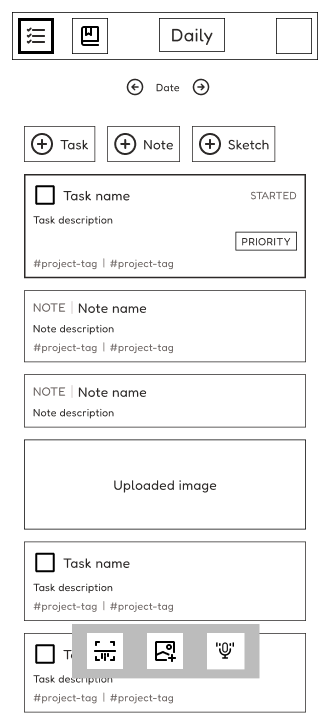
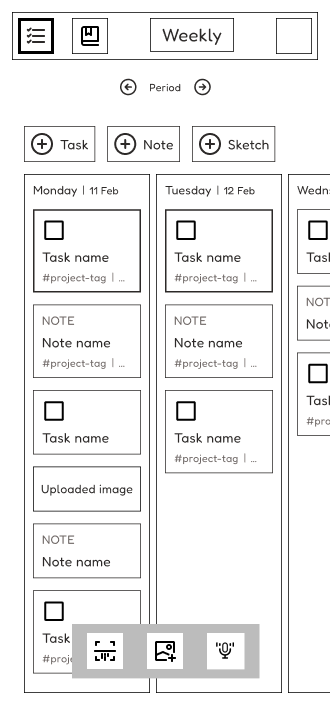
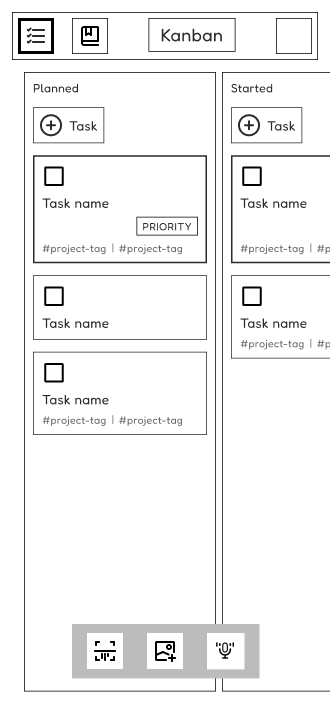
Projects page
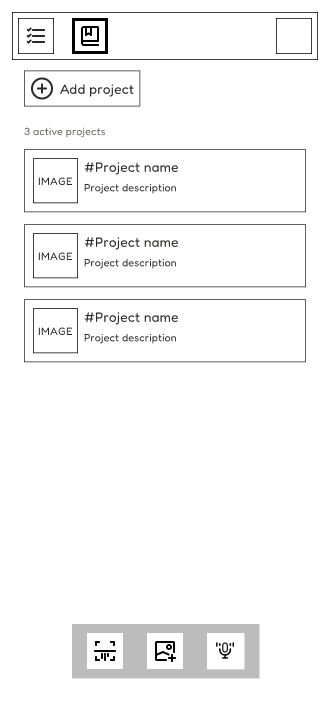
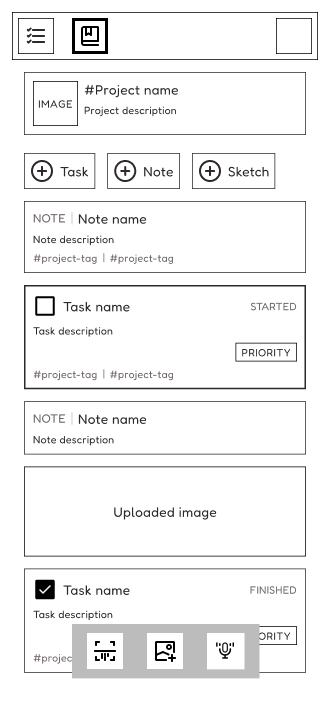
“Mobile-first approach”
#Wireframing
Wireframes on Tablet
I extended the same direction and core sections to tablet, adapting the functionality to a larger screen. This allowed me to explore how the layout would better support usability.
Task page
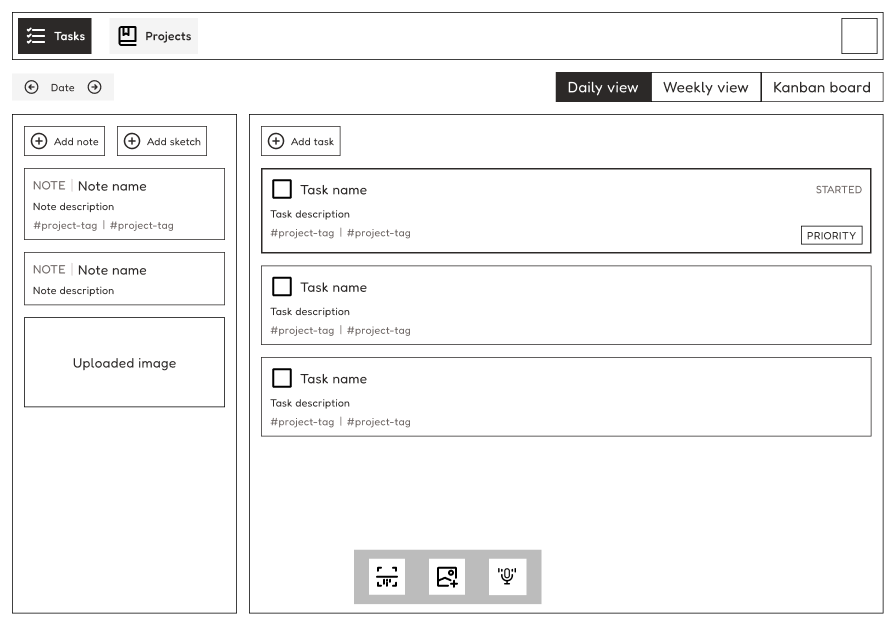
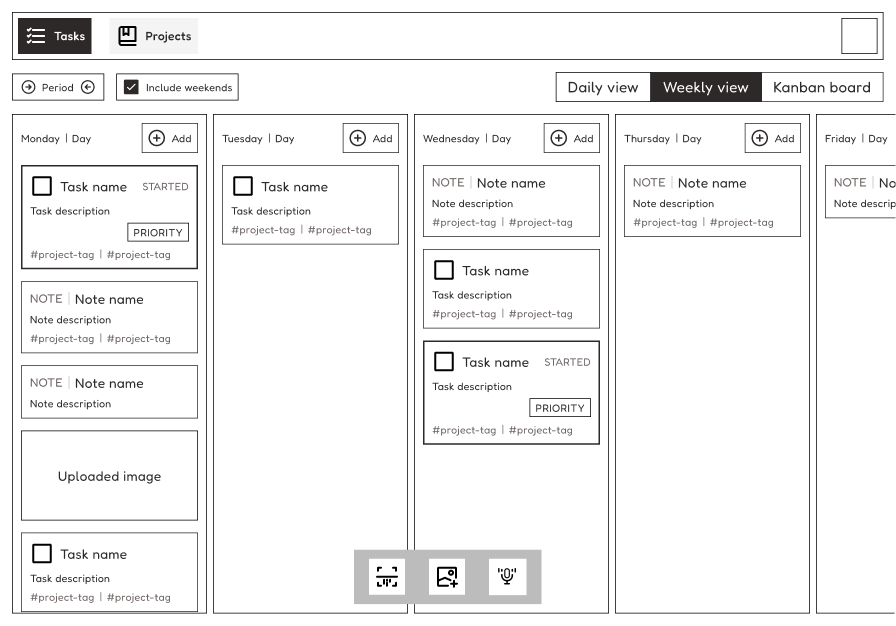
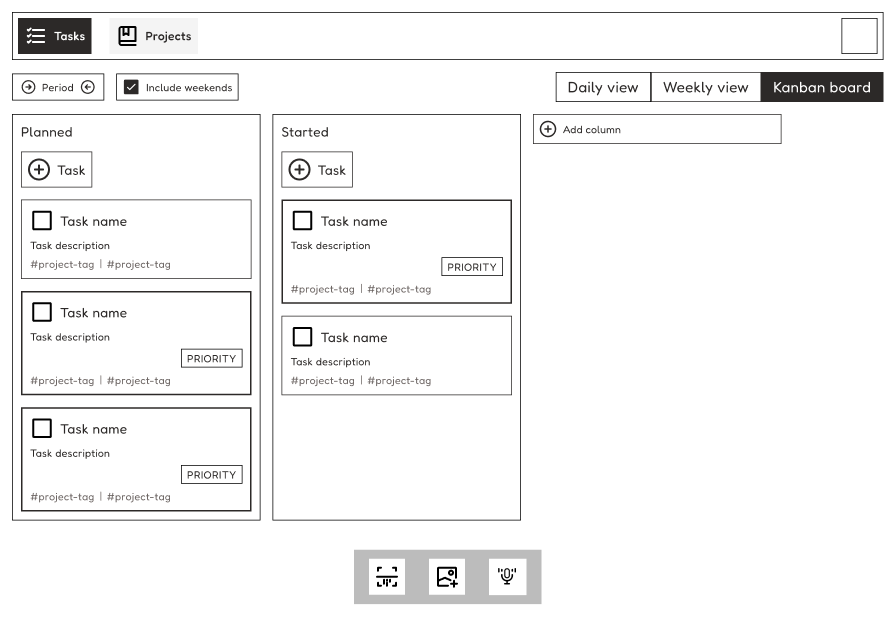
“Tablet optimization is the next priority”
#Wireframing
First Concepts Finished – High-Fidelity Design Mockups
After exploring wireframes and interaction patterns, I moved into high-fidelity mockups to refine the look and feel of the product. At this stage, the focus shifted from structure to detail: typography, spacing, and visual hierarchy.
Mobile view
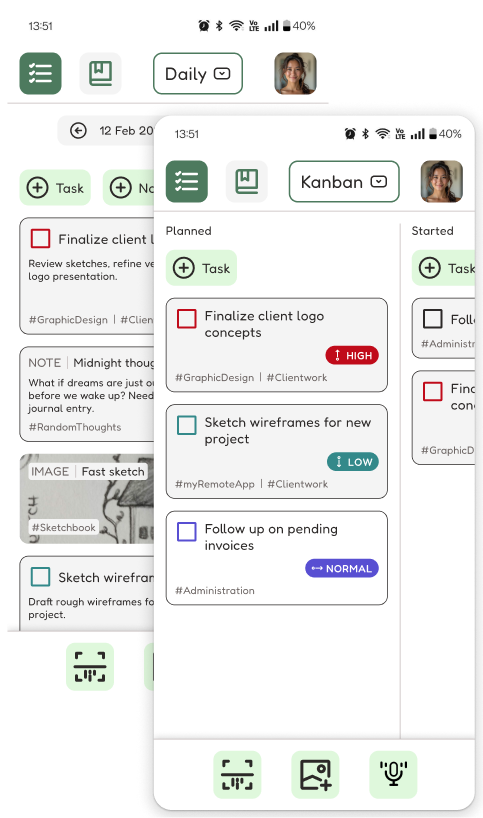
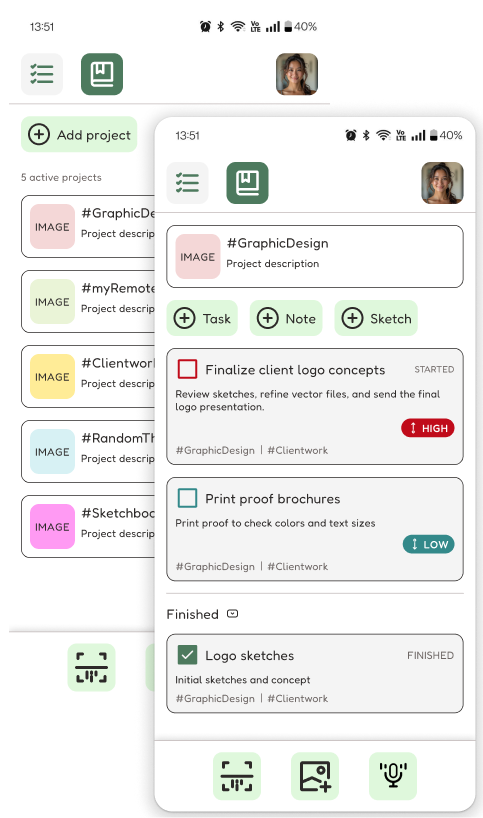
Tablet view
“These mockups also will serve as a bridge between concept and implementation.”
#Prototyping
Introducing OCR technology
Optical Character Recognition is the process that converts an image of text into a machine-readable text format
Scanning and organizing via OCR Technology
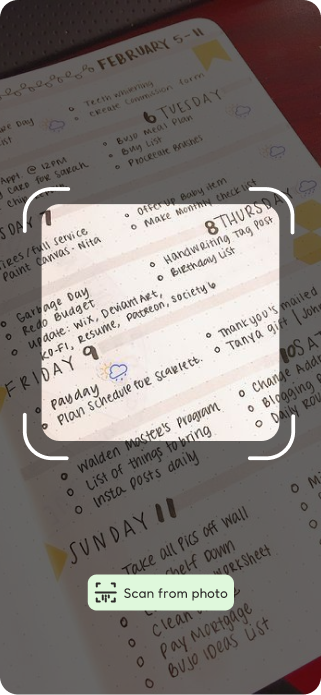
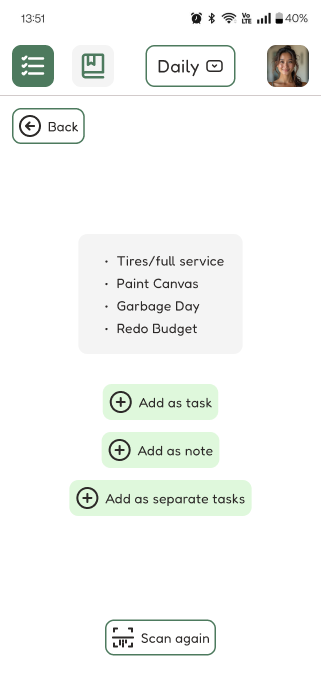
“A concept of one way how scanning, organizing, and editing will work together”
Next steps
Testing & Iterations
To ensure MyndNotes App meets user needs effectively, the following testing methods will be used:
Testing
- Usability testing
Observing users as they interact with MyndNotes App to identify pain points and areas for improvement - Prototype testing
Conducting tests with low-fidelity and high-fidelity prototypes to refine the design and interactions - Feedback sessions
Gathering direct input from creative professionals to validate functionality and usability
Iteration Plan
- Initial prototype & feedback rounds
Develop a wireframe prototype and test with a small group of target users - Refinement based on insights
Implement improvements based on initial feedback - Beta testing
Launch a beta version for real-world usage and collect further insights
Impact & Future vision
MyndNotes App aims to evolve into a more complex tool that supports creative professionals beyond note-taking. Future enhancements include
Features and Future vision
- Advanced collaboration features
Enabling sharing of notes, tasks, and projects for teams - Customizable templates
Offering predefined templates for brainstorming, project planning, and journaling - Voice-to-text & audio notes
Allowing users to capture ideas through voice recordings and automatic transcription - Integrations
Expanding compatibility with apps like Figma, Notion, and Google Calendar - AI-powered insights
Using AI to suggest related notes, prioritize tasks, and improve organization
Designed by a creative: